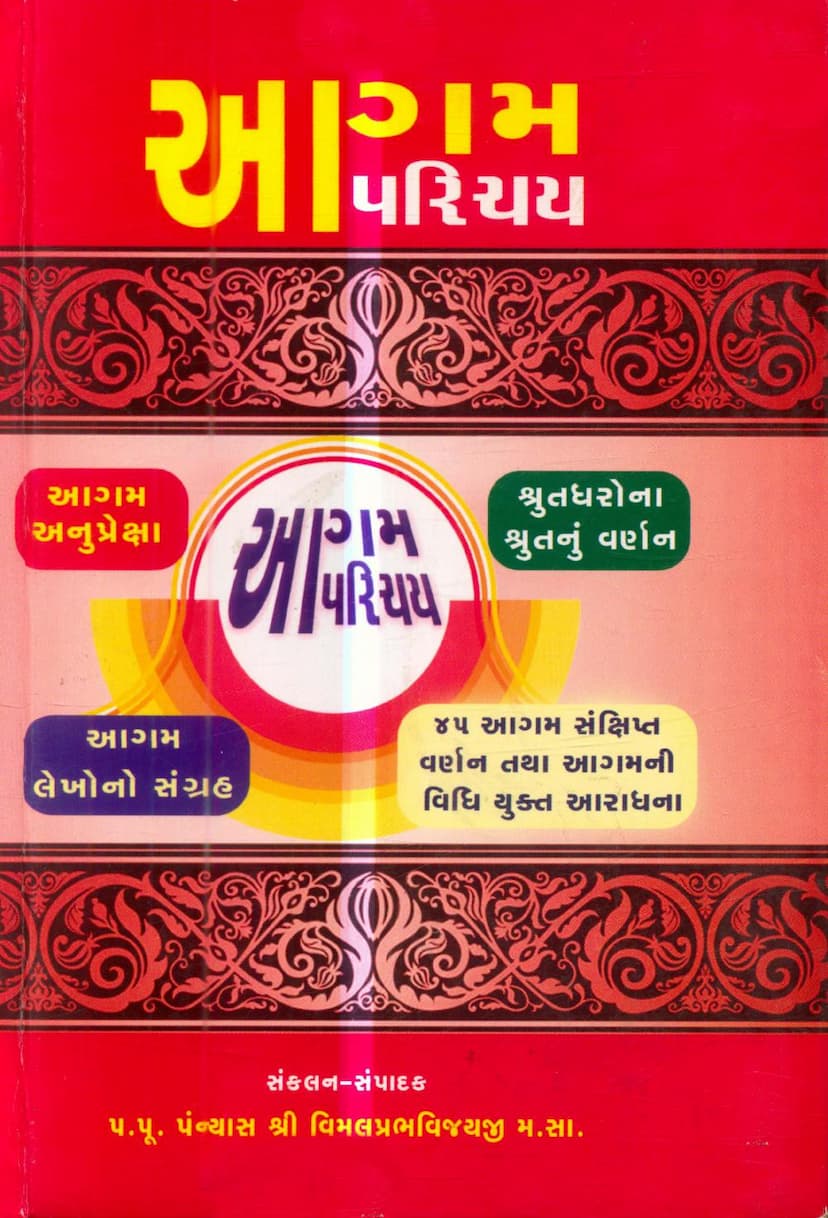Agam Parichay
Added to library: September 1, 2025
Loading image...

Summary
This Jain text, titled "Agam Parichay" by Vimalprabhvijay, serves as an introductory guide to the Jain Agamas, the foundational scriptures of Jainism. Compiled and edited by P.P. Punyas Shree Vimalprabhvijayji M.S., the book aims to provide a concise overview and understanding of these sacred texts for the benefit of spiritual seekers.
Key Content and Themes:
- Introduction to the Agamas: The book highlights the critical importance of the Agamas as the "speaking God" (bolta Bhagwan) in the current era, with Jain idols being the "silent God" (mon Bhagwan). It emphasizes that the Agamas are essential for spiritual guidance and understanding the path to liberation (moksha).
- Compilation and Sponsorship: The publication of this book was made possible through the generous contributions of various Jain Sangh (organizations) and individuals, listed as "Aadhaar Stambh" (supporting pillars), indicating a collective effort to disseminate Jain knowledge.
- Content Breakdown: The text provides a brief introduction to 45 Agamas, their secrets, and contemplation (anupreksha). It includes descriptions of the deaths of great souls (shruta-dharon-na-mrutyu-nu-varnan) and a collection of articles related to the Agamas.
- The Significance of Shruta (Agamas): The book strongly advocates for respecting and studying the Agamas, asserting that they are the root for understanding the divine (Deva), the spiritual guide (Guru), and the true Dharma. It explains that even omniscient beings (Kevalis) are not superior to the Agamas in terms of their benefit to the ordinary soul, as the Agamas reveal the nature of reality that is otherwise unknowable.
- The 24 Tirthankaras and the Agamas: The text mentions that the 24 Tirthankaras, through their teachings, laid the foundation for the Dwadashangi (the collection of 12 limbs of Agamic literature), which was further developed by Ganadharas.
- Preservation of the Agamas: It touches upon historical efforts to preserve the Agamas, such as the compilation by Devardhigani Kshamashraman in Vallabhi in VS 980, and the commentaries written by Acharya Shilanka and Acharya Abhaydeva Suri.
- Detailed Description of 11 Angas and 12 Upangas: A significant portion of the book is dedicated to a verse-by-verse, chapter-by-chapter, and sometimes even verse-specific explanation of the 11 Angas and 12 Upangas. For each Agama, it provides:
- Names and Key Themes: Briefly describes the content of each Agama, such as the rules of conduct in Acharaang, the philosophical discussions in Sutrakrutanga, the categorization of things in Sthanaanga, the classification of phenomena in Samavayaanga, the detailed explanations in Bhagavati Sutra, narratives in Gyata Dharma Katha, the lives of householders in Upasakadasha, the lives of great ascetics in Antakrutadasha, the descriptions of celestial beings and hellish beings in Anuttaraupapaticadasha, the philosophical dialogues in Prashna Vyakarana, the consequences of actions in Vipaka Shruta, and the descriptions of hellish beings in Nirayavalika.
- Rituals and Practices: For many Agamas, the text details specific rituals associated with their study or recitation, such as 'pradakshina' (circumambulation), 'sathiya' (a ritualistic drawing), 'khamasamana' (a specific penitential bow), and 'logassa' (a scripture recitation). It also mentions mantras like "Om Hri Shree Acharaanga Sutraya Namaha".
- Key Concepts and Examples: The book delves into the core teachings within each Agama, illustrated with examples. For instance, Acharaanga is presented as a guide to elevating one's life through developing affection for all beings, emphasizing the purity of conduct through the practice of non-violence towards the six types of living beings. Sutrakrutanga is highlighted for establishing the Syadvada principle and refuting various philosophical viewpoints.
- Emphasis on Devotion and Practice: Throughout the descriptions, there's an underlying emphasis on the importance of devotion (Bhakti), adherence to prescribed rituals, and the ultimate goal of achieving liberation through virtuous conduct.
- The Role of Sages and Teachers: The text frequently mentions the efforts of past Acharyas and scholars in compiling, commenting on, and preserving the Agamas, underscoring the importance of lineage and guidance from learned preceptors.
- The Nature of Knowledge: It suggests that true knowledge (Jnana) is not just about accumulating information but about contemplation (Anupreksha) and internalizing the teachings for spiritual realization.
- The Importance of Human Life: The book implicitly emphasizes the preciousness of human life as an opportunity for spiritual growth and liberation, attainable through the study and practice of the Agamas.
- The Hierarchy of Knowledge: The text subtly implies a hierarchy where the Agamas are the ultimate source of knowledge, guiding even the understanding of the divine.
In essence, "Agam Parichay" is a valuable resource for anyone seeking to understand the vast and profound world of Jain Agamas. It serves as an accessible entry point, providing foundational knowledge and encouraging further study and practice of these ancient scriptures.